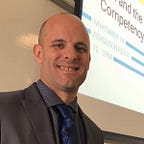Standards and Skills Part 2 — Curriculum is the future
The first part of my review of “Beyond Standards” was admittedly very short due to time and energy limitations and this one will be too. I still highly recommend anyone involved in teaching, school administration, or education policy read it.
But the most exciting part of the book for me came when there was discussion about Curriculum creation. There was a lot of talk about NYC’s Engage NY which also spawned Eureka Math . Less talk because it’s newer was about Illustrative Mathematics’ math curriculum, which was born out of the K12OER collaborative. Illustrative in turn has been featured or adapted in OUR, Desmos Math Curriculum, and probably others. I wrote about these when they first came out here .
There’s nothing better in a classroom then giving students engaging, high quality tasks that they talk about even years later. And most of the time I never saw anything from published sources that created that kind of curiosity because it had to be ‘easy’ for the teacher to implement — read — lack of ambiguity. What excites me most about curriculum is that the focus isn’t on testing but on creativity.
Branches for Diverse Curriculum built on a Common Core*
The idea of having a ‘base’ set of content, formative assessments, and guided learning progressions that expands, where companies can add services and nuances to make implementation easier etc is exactly the same playbook that grew the Linux/GNU operating system from nothing in 1992 to something that’s virtually ubiquitous now. What helped grow and maintain that ecosystem was in large part a piece of technology for version control called Git created in 2005. As opposed to in Google docs where anyone can type anything, Git makes sure that only specific pieces (of code) are overwritten with permission. One metaphor I love from Git is the idea that there can be several different ‘branches’ of software that can be maintained with the same core over time. So, while I get the lesson plans shouldn’t be put up in a repository like teachers pay teachers (but free), I do feel that the core content pieces themselves should be. Put simply, to me ‘curriculum’ is the narrative for the teacher that discusses the Progressions being emphasized, a lesson
narrative (but not necessarily a granular lesson plan), and problem sets. Or showing how teachers can introduce simple problems that build into three-act math tasks or open middle type problems, and formative assessments along the way that are appropriate.
I envision it is possible now to create a core set of materials that could have ‘branches’ for topics or population groups like spanish speakers (same content automatically translated), special education or ‘lower grade level text’, technology enhanced or technology-lacking. The SFUSD curriculum in particular I think does a great job of this — showing the teacher pages but also relevant student pages with examples, printable handouts etc.
The Unbundling of Curriculum
I hope curriculum will soon be like how we used to pay for cable and get mostly everything, but now pay for multiple streaming services for specific sectors of content. However, good curriculum is NOT just a bunch of bite sized content or episodes 1–8 of Friends. I worked for a company that curated open educational resources (mostly videos) and the quality difference across our catalog as well as coherence within grade levels was inherently fragmented. That is, one video could have talked about the ‘area model’ of multiplication, and another video covering the same standard not have a mention of that at all. Truly integrated curricular content needs to be validated, use the same kinds of vocabulary words, and have strong ties to the standards and instructional frameworks (such as the ELD Framework in California)
When the content is tagged to a spine of content/contextual/delivery skills that include progressions and other important metadata to ensure that the content matches up and forms a cohesive element, then there is a chance for success. This is where machine learning with tagged content as well as AI to help find differentiation cues can help (… another post!).
The future of education is not software. It’s content.
*”Common Core” not referring to the ‘common core state standards’ but I couldn’t resist a common core joke.
